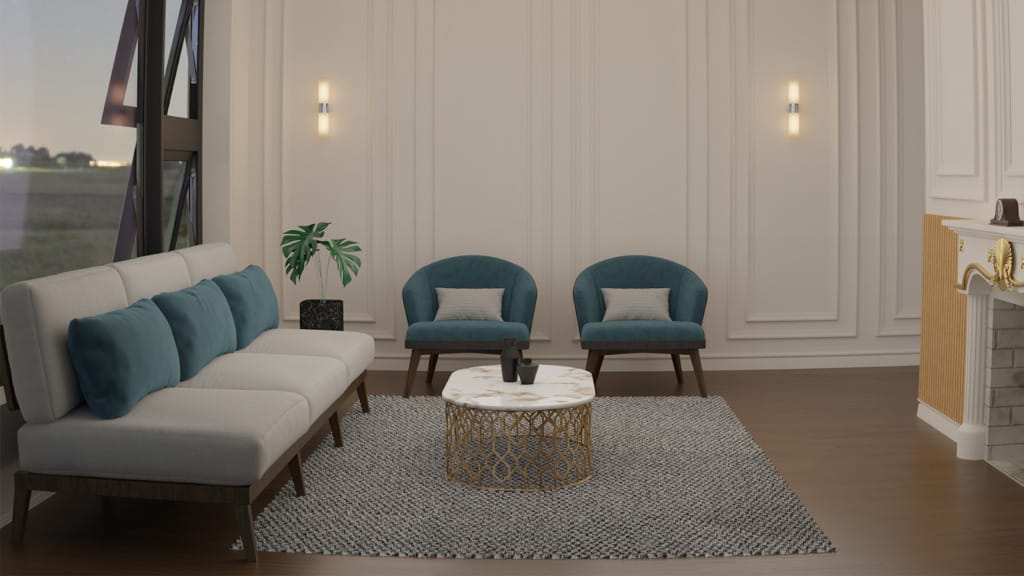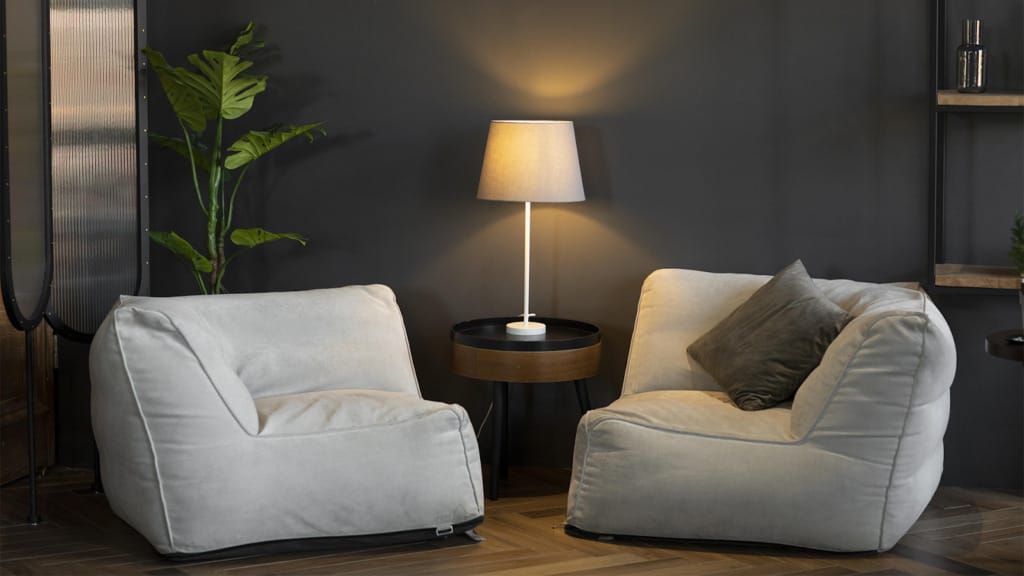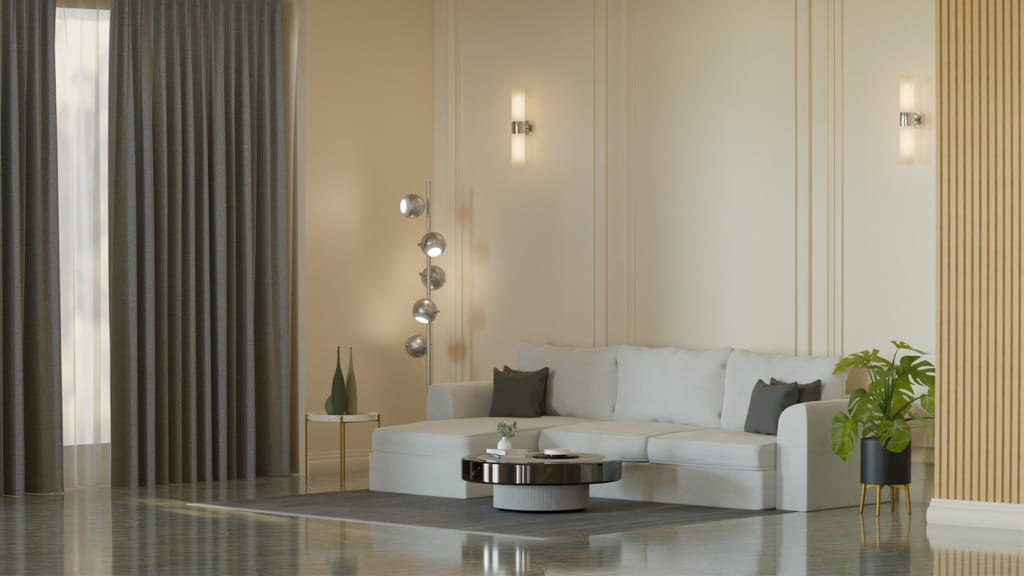You move into a cozy apartment, hang your art, arrange the sofa, plug in a lamp… and then the sun goes down. You flip the wall switch out of habit and are met with darkness. No overhead fixtures, no ambient glow. It’s a common scenario for renters, old wiring, ceiling restrictions, historic buildings, or just a lean renovation budget can leave you without a ceiling light box.
The good news is that you don’t need a hardwired chandelier to create a bright, inviting space. Modern products and clever design tricks mean you can improve lighting in a room with no overhead fixtures, using plug‑in and battery‑operated options that look custom. This comprehensive guide covers everything you need to know about no ceiling light solutions. You’ll learn how to layer ambient, task, and accent light; explore plug‑in lighting ideas like swag‑style pendants and adhesive wall sconces; master floor lamp placement; and discover rental‑friendly lighting options that pack a punch without risking your security deposit.
Why Overhead Fixtures Are Missing & What It Means for Your Plan
Before diving into solutions, it helps to understand why ceiling lights are absent. If you’re renting in an older building, there may never have been a junction box installed. Many pre‑war apartments relied on natural light during the day and floor lamps at night. In other cases, the electrical system may not support additional fixtures safely. Landlords often avoid hardwired lighting to save on maintenance and liability. Even in newer builds, designers sometimes leave out overheads for budget reasons or to give homeowners the freedom to choose their own fixtures. Regardless of the cause, the absence of a ceiling fixture means you must think in layers: ambient light for overall brightness, task light for specific activities, and accent light for mood and focal points. Each layer can be achieved without hardwiring by using plug‑in or battery‑powered options.
Layered Lighting 101: Ambient, Task & Accent Without a Ceiling Box
Lighting professionals talk about three tiers of illumination:
- Ambient light provides general brightness and sets the mood. Overheads, recessed cans and chandeliers typically do this job, but you can approximate the effect with large floor lamps, plug‑in pendant lights hung from ceiling hooks, LED strip moulding at the crown, or a cluster of wall washers. Ambient light should bounce off walls and ceilings, creating an even glow that fills the room.
- Task lighting is focused illumination for reading, cooking, grooming or working. Think of swing‑arm lamps by a sofa, directional sconces over a desk, or a clamp light clipped to a bookshelf. Task lights aim light exactly where you need it and prevent eye strain.
- Accent lighting adds drama and draws attention to art, architectural features or collections. Picture lights over artwork, uplights in a bookcase, small LED puck lights on shelves or strip lights under a cabinet fall into this category. Accent lights are usually lower wattage and highlight rather than illuminate.
Without a ceiling fixture, your job is to combine these three types at different heights, from floor to mid‑level to near the ceiling, to avoid a “spotlight” effect. Spread your sources around the room so that light doesn’t all emanate from one corner.
Plug‑In Solutions That Look Built‑In
The term no ceiling light solutions encompasses a wide range of products and strategies designed to bypass the need for hardwiring. Today’s market offers plug‑and‑play pendants, b, adhesive wall sconces, corner floor lamps, and more. Because they require no electrical installation, these options are ideal for renters, historic homes, and budget‑conscious homeowners.
Arched Floor Lamps for Central Glow
An arched floor lamp is the closest analogue to an overhead light. Choose a lamp with a long, curved arm that reaches toward the center of the room. Position the base behind your sofa or in a corner and let the shade hover over your coffee table or reading nook. For a cohesive look, coordinate the finish (brass, black, nickel) with your existing fixtures. Opt for models with fabric or frosted glass shades to diffuse light. Most modern arched lamps accommodate LED bulbs, which provide plenty of lumens while using minimal wattage. Positioning one of these lamps centrally creates a wide pool of ambient light without any wiring.
Plug‑In Pendant & Swag Kits
If you long for the look of a hanging fixture, plug‑in pendants are your friend. These kits include a corded pendant light and swag hooks. Simply screw a hook into the ceiling where you want the light to hang, drape the cord across, and plug it into a nearby outlet. Use wall‑mount cord channels or paintable cord covers to keep the wire neat along the wall. Paper lantern pendants lend a soft, diffused glow; fabric drum shades add a tailored look; glass globes feel modern. You can even choose plug‑in chandeliers with multiple bulbs for extra brightness. When placing a pendant over a dining table or seating area, hang it about 30–36 inches above the surface. If you’d prefer a more built‑in look, explore plug‑in sconces that install with brackets and hide the cord under a cover — they’re perfect for flanking a bed or sofa.
LED Strip Moulding Along Crown
LED strip lights, when tucked into crown moulding or hidden behind a cove, can mimic the wash of ceiling fixtures. Flexible strips come with adhesive backing and can be cut to size. Stick them along the top of the wall or the underside of floating shelves to bounce light upward. Look for dimmable strips with warm white (2700–3000 K) colour temperatures for a cozy feel. For more ideas on using LED strips, check out our guide on brightening dark corners with LED strips for inspiration.
When installing, plug the strip’s driver into a wall outlet and hide the cord behind furniture or inside cord covers. Use an inline dimmer switch or smart plug to adjust brightness. This technique works especially well in rooms with tall ceilings, adding a soft halo that makes the space feel taller and brighter.
Picture & Bookcase Uplights
To highlight artwork or books while adding ambient light, use plug‑in picture lights or bookcase uplights. These slim fixtures attach to the top of frames or shelves and shine upward, washing the wall with a glow that draws the eye. Many models are dimmable and come in brass or matte black finishes to suit different styles. When selecting, aim for around 200–300 lumens per fixture for accent lighting.
For a seamless look, use cordless rechargeable picture lights; they attach with screws or adhesive, and you simply recharge the battery every few months. Picture lights not only illuminate your art but also provide soft fill light that prevents the room from feeling flat.
Wireless & Battery‑Powered Options for Renters
If you’re unable to drill into walls or run cords along baseboards, there’s a growing array of rechargeable and battery‑operated lighting solutions.
Rechargeable Bulbs & Stick‑On Sconces
Rechargeable light bulbs screw into standard sockets but hold a charge, allowing them to operate even when unplugged. Pair one with a plug‑in pendant kit or lamp to create a cordless look. Battery‑powered stick‑on sconces offer another simple fix: mount them with adhesive strips and peel them off later without damage. Some models use magnetic bases so you can detach the sconce to recharge it. Look for features like dimming, colour temperature adjustment and timer settings. Stick‑on sconces are ideal beside a bed, above a gallery wall, or in hallways where you don’t have outlets.
Motion‑Activated LED Bars
Motion sensors are a renter’s best friend in spaces with no overheads. Slim LED bars with built‑in sensors stick under cabinets, inside closets or along hallways. They turn on when you walk by and turn off automatically, saving battery life. Use them inside wardrobe cabinets, under shelves, or along stair treads. For reading nooks or desks, choose bars with a warm colour temperature and brightness of 50–100 lumens.
Smart Battery Lamps with App Control
Battery‑powered lamps are evolving quickly. Many now connect to smartphone apps via Bluetooth or Wi‑Fi, allowing you to adjust brightness and colour temperature or set schedules. Look for rechargeable table lamps with built‑in batteries that last 10–20 hours per charge. Place them on nightstands, kitchen counters or in bathrooms where outlets are scarce. Pair them with smart plugs or a multi‑socket floor switch for easier control. For more renter‑friendly hacks, explore our article on renter‑friendly DIY lighting.
Mirror & Surface Tricks to Double Your Light Output
Lighting the surfaces in your room can either absorb or reflect light. By strategically placing reflective surfaces, you can amplify every lumen.
- Hang mirrors opposite windows: A large mirror on a wall across from a window will bounce daylight deeper into the room. Even at night, a floor lamp placed near a mirror doubles its effect by reflecting its glow.
- Use metallic accents: Brass, chrome, mirror‑finish furniture or even metallic picture frames act like mini reflectors. A coffee table with a glass or metal top will scatter light around and make a space feel brighter.
- Glossy finishes: High‑gloss paint on furniture or lacquered decor elements can reflect light; glossy white or pastel walls also bounce artificial light better than matte dark tones.
- Mirrored art and decorative panels: Art pieces with mirrored or metallic backgrounds add both style and functionality. Similarly, mirrored backsplash tiles in the kitchen can help distribute under‑cabinet lighting.
For a deeper dive into using mirrors effectively, see our mirror tricks guide.

Staging Hacks: Hide Cords & Create Focal Glow
Once you’ve chosen your fixtures, think about presentation. Professional stagers understand that cords and messy wiring can ruin the illusion of a custom installation. Here’s how to keep things tidy:
- Cord covers and raceways: Paintable plastic covers and cable raceways adhere to baseboards or walls, concealing cords so they blend with your decor. For rental properties, choose adhesive versions that remove cleanly.
- Rug channels: Run extension cords beneath rugs or carpet edges, but ensure they are rated for floor use. Secure cords with gaffer tape or flat cord covers designed to prevent tripping.
- Hide behind furniture: Route cords along the back of sofas, bookcases or consoles. Use clear clips or Velcro ties to keep them from sagging.
- Multi‑socket floor switch: A foot‑operated power strip allows you to turn multiple lamps on with a single tap. Hide the strip under a side table or behind a plant, and label each plug for easy troubleshooting.
- Create a focal glow: In staging, it’s not just about brightness but also about directing the eye. Use a statement lamp, picture light or pendant to draw focus to a gallery wall or a beautiful shelf. Then fill in with ambient sources at the periphery. This layered approach creates depth and makes the room feel curated.
Quick Budget Breakdown: $50, $150, $300 Lighting Upgrades
Lighting doesn’t have to break the bank. Here’s how you can transform a dark room at three different budget levels:
$50 Lighting Upgrade
- Rechargeable stick‑on sconces: Purchase two adhesive sconces with rechargeable LED bulbs (~$20 each). Mount them on either side of a headboard or above art. They’ll provide 80–100 lumens each for reading or accent light.
- LED bar for under‑shelf lighting: A motion‑activated bar (~$10) can brighten a bookshelf or closet. Place it under a shelf to illuminate a display or inside a wardrobe for easier outfit planning.
- Battery‑powered table lamp: A small cordless lamp (around $20) can sit on a side table or kitchen counter. Look for dimmable models with warm light to add cozy ambiance.
Total cost: ~$50; approximate lumen output: 250–300 lumens distributed across three sources.
$150 Lighting Upgrade
- Plug‑in pendant light: Choose a stylish plug‑in pendant kit (~$60) with a fabric shade and a 10–15‑foot cord. Use a swag hook to position it over a dining table or reading nook.
- Arched floor lamp: A basic arc floor lamp (~$70) with a 5–7 watt LED bulb can cast 500–600 lumens over your seating area.
- Mirror upgrade: Invest in a mid‑sized decorative mirror (~$20) to reflect light from your new fixtures. Hang it opposite the pendant or across from a window.
Total cost: ~$150; approximate lumen output: 800+ lumens plus reflected light.
$300 Lighting Upgrade
- Premium arc lamp with multiple heads: A high‑quality arc lamp with multiple heads or adjustable arms (~$150) can provide both ambient and task light. Choose one with dimmable LEDs and a weighted base.
- Plug‑in picture lights or wall washers: Add two plug‑in picture lights (~$50 each) above artwork or built‑ins. Look for models with adjustable brightness and swivel heads to direct light.
- LED strip moulding kit: Install a professional‑grade LED strip kit (~$40) along the crown moulding or behind a floating shelf. Ensure it’s dimmable and provides at least 1,500 lumens.
- Smart plug system: Use a smart plug or power bar (~$30) to control all fixtures via app or voice assistant. Schedule lights to come on before sunset or create scenes for movie nights.
Total cost: ~$300; approximate lumen output: 2,000+ lumens evenly dispersed, with full control over brightness and colour temperature.
Common Mistakes That Keep a Room Looking Dim
Even with the right products, poor placement or mismatched bulbs can leave your room feeling dark. Avoid these pitfalls:
- Relying on one floor lamp: One lamp in a corner cannot illuminate an entire room. Use multiple light sources at different heights for balanced coverage.
- Ignoring colour temperature: Mixing warm (2700 K) and cool (5000 K) bulbs can create discordant lighting. Aim for consistent temperatures within a range of ±300 K to avoid jarring transitions.
- Blocking windows: Furniture, heavy drapes or large plants can obstruct natural light. Keep window treatments light and airy, and place tall items to the side to allow sunlight to penetrate.
Not using dimmers: Lamps that are either “on” or “off” offer no flexibility. Inline dimmer switches or smart bulbs let you tailor the intensity to the time of day and mood. - Forgetting accent and task layers: Ambient light alone can feel flat. Add task lamps by reading chairs and accent lights on bookcases or artwork to add depth and warmth.

Final Checklist & Next Steps
- Assess your space: Note where natural light comes in, what activities happen in each zone, and where outlets are located. Identify dark corners and focal points.
- Choose your ambient sources: Decide on an arc lamp, plug‑in pendant or LED strip along crown moulding. Make sure the combined lumen output meets your needs (aim for 20 lumens per square foot for living rooms).
- Add task lights: Select reading lamps, desk lights, or swing‑arm sconces for areas where you read, work or prepare food.
- Layer in accents: Add picture lights, small uplights, LED strips under shelves or battery‑powered pucks to highlight art and architecture.
- Plan cord management: Use cord covers, rugs, or furniture to hide wires. Consider a multi‑socket floor switch or smart plug to control multiple lamps easily.
- Include reflective surfaces: Hang mirrors, use metallic or glossy accents, and keep window treatments light to maximize both natural and artificial light.
- Set a budget: Start with affordable fixes like stick‑on lights or battery‑powered lamps. Upgrade to arc lamps and pendants as your budget allows.
- Avoid the common mistakes: Don’t rely on a single lamp or mismatched bulbs. Use dimmers and consistent colour temperatures for a professional finish.
FAQs
Can I install a ceiling light without attic access?
Installing a hardwired ceiling fixture without attic access often requires cutting into the ceiling to run wiring, which typically isn’t permitted in rentals and can be expensive in owned homes. Instead, opt for plug‑in pendant kits that hang from ceiling hooks and plug into nearby outlets. These provide overhead illumination without the need for electrical work.
What’s the brightest plug‑in floor lamp on the market?
Brightness depends on the bulb and shade design. Look for arc floor lamps that accept standard E26 LED bulbs; bulbs labeled 100 W equivalent (around 1,600 lumens) will provide plenty of light. Choose a lamp with a wide shade and a reflective interior to maximize output. Brands that market “high‑lumen” or “task” lamps often specify lumen ratings; aim for 800–1,200 lumens for general lighting.
Are battery sconces bright enough for reading?
Battery‑powered sconces can work for reading if you choose models with at least 150–200 lumens and adjustable heads. Rechargeable sconces are generally brighter than models powered by small AA batteries. For long reading sessions, combine a battery sconce with a dedicated reading lamp or clip light for additional focused light.
How do I hide cords across a hardwood floor?
Use flat cord covers designed for floor use, sometimes called floor raceways. They allow cords to run safely across pathways without creating tripping hazards. Another trick is to run cords along the perimeter of the room under the baseboard, securing them with clear clips and covering them with paintable raceways. In open floor plans, hide cords under area rugs or carpet tiles.
Is smart lighting worth it for staging?
Smart lighting can be a powerful tool for staging because it allows you to create scenes, schedule lights to turn on before a showing, and adjust brightness remotely. However, it isn’t strictly necessary. If you’re on a tight budget or staging a short‑term rental, focus on layering your lighting and hiding cords; you can still achieve a professional look without high‑tech gadgets.
Ready to transform your dark room into a bright, welcoming space by improving the lighting in the room with no overhead fixtures? The Staging Place will help you plan a layered lighting scheme tailored to your room’s layout, style and budget, ensuring your home shines in its best light.
Ready to transform your dark room into a bright, welcoming space by improving the lighting in a room with no overhead fixtures? The Staging Place will help you plan a layered lighting scheme tailored to your room’s layout, style, and budget, ensuring your home shines in its best light.


